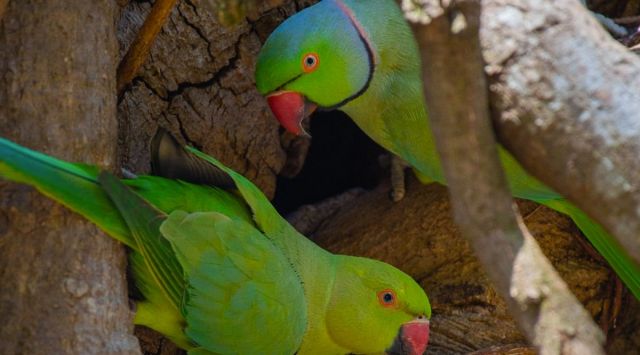Birds Without Borders: Rose-ringed parakeet, the vehicle of Kamdev and Rati
The female lays one to seven eggs and hatches them for 21 days. Both the parents feed the chicks.
 Two rose-ringed parakeets at Gir forest in Gujarat during monsoon. (Photo: Dr Jayendra Bhalodiya)
Two rose-ringed parakeets at Gir forest in Gujarat during monsoon. (Photo: Dr Jayendra Bhalodiya) Rose-ringed parakeets or parrots (scientific name: Psittacula krameri) are known for their mimicking skills. People used to train them to speak different words and greetings; even fortune tellers used parrots to pick cards. Apart from such observations, something impressive is their way of wooing.
The male moves closer to the female and lifts one leg up and down two to three times to gain the female’s attention. Once the female starts to notice him, he quickly extends his neck and body towards her and locks the bills. They don’t mind sticking their tongues. After the bill lock, he opens his wings from his shoulders, moves his body in Shahrukh’s style of extending arms, and turns his head towards the female with a glamorous look. They exchange gentle bites on the neck and head. Moreover, the male also makes mild wooing sounds.
Food plays a big role in rose-ringed parakeets’ pairing. The male offers regurgitated food to the female to win her heart. Sometimes, a cheeky male moves his leg up and down and pretends that he is trying to bring regurgitated food up to get a chance to lock the bills. But the female knows this trick, and if she realises the pretension, she retracts her head without locking the bills.
Parrot is believed to be the vehicle of Kamdev, the god of desire and erotic love in Hindu mythology, and his wife Rati. Parrots mate for a season only. They mate with a new partner every season.
Rose-ringed parakeets are named after the pink rose and roundish collar at their nape. The collar at the neck is black. Usually, the male has such a collar, sky blue shade on its head and nape, slightly flattish crown and black lines in its lore — the region between its beak and the eyes. The female has no coloured-collar or sky shade, and her crown is more roundish. Moreover, her bill and body colour is comparatively paler. They have green upper body and wings. Their chest and belly are yellowish-green. They have a thick, red, curvy and short beak, which is pointy at the end.
Parrots have orange-red circles surrounding their eyes. Moreover, the parrot’s tail has blue feathers in the middle. They also have a blue colour morph. Parrots can hold onto and climb tree trunks vertically due to their fingers’ placement. Their feet have two fingers at the front and two at the back. They have short legs though. Due to that, they walk really slowly. In persuasion also, they use slow walks to approach the mate. Parrots roost in a group. They don’t mind chasing birds of prey to ensure safety from intruders.
Rose-ringed parakeets eat grains, seeds, fruits, dates, buds, sunflowers and sometimes even tree bark. It is believed that if a parrot has taken a bite from the guava fruit, then it is certainly sweet. They often feast on millets and other crops and can be spotted flying off with panicles of pearl millet after cutting them from their stems by using their powerful beaks. Parrots are social birds. They forage in a group during the daytime and rest at night. They nest in tree holes and concrete holes carved with their beak. They also use tree hollows. The female lays one to seven eggs and hatches them for 21 days. Both the parents feed the chicks.
Parrots are widely spread across the globe and found in very diverse habitats. They can be found in Africa, Asia, Europe, shrubland, savanna, mangroves, wetlands, cities, gardens, cold places with temperatures below 10 degrees Celsius and hot places above forty degrees Celsius. They are common resident birds in Gujarat.
The International Union for Conservation of Nature (IUCN) Red List categorises rose-ringed parakeets as Least Concern species. They are widely found, and their population is increasing. Due to their increasing population, sometimes they pose a threat to other species, such as common noctule bats. They compete for the tree holes to nest, and parrots may kill them in fights.
Next time you see a green flock squawking loudly, you will surely think of romantic rose-ringed parakeets and their bill locks.
(Dr Jayendra Bhalodiya is an assistant professor at Ahmedabad University. He is affiliated with Bird Conservation Society, Gujarat and Eco Friends Gujarat.)












